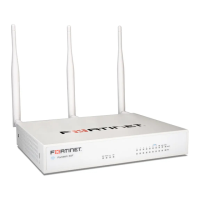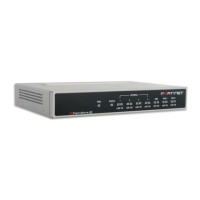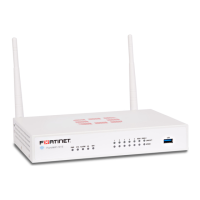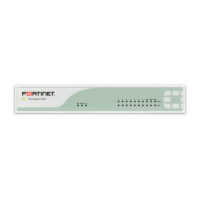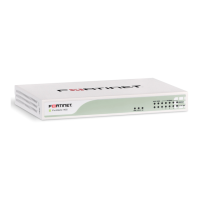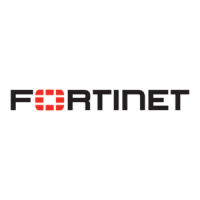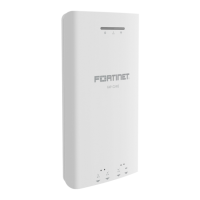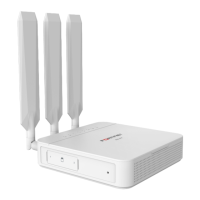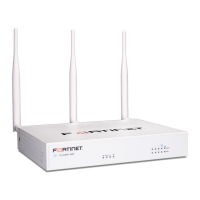Do you have a question about the Fortinet FortiWAN and is the answer not in the manual?
Details the advantages of FortiWAN, focusing on performance, cost, reliability, and application support.
Explains the mechanisms for managing and distributing workload across multiple WAN links for optimal performance.
Provides initial setup instructions for the FortiWAN appliance, covering network topology and interface configuration.
Explains how FortiWAN handles network data transmission bidirectionally, covering both inbound and outbound sessions.
Describes how FortiWAN distributes traffic across multiple WAN links using load balancing algorithms for outbound traffic.
Explains how FortiWAN balances incoming requests across multiple WAN links to improve user response and network reliability.
Details how FortiWAN detects and handles WAN link failures, allowing automatic switch-over to redundant links.
Lists bug fixes and new features introduced in FortiWAN version 4.2.1.
Details new features and enhancements in FortiWAN version 4.2.0, including IPSec VPN and Tunnel Routing.
Details enhancements and changes made to the documentation for FortiWAN 4.2.1.
Lists document enhancements and changes for FortiWAN 4.2.0, including new pages and updated content.
Instructions for registering your Fortinet product to access customer services like firmware updates and technical support.
Guides on planning the network topology for load balancing and fault tolerance between different networks.
Defines Wide Area Network (WAN), Local Area Network (LAN), and Demilitarized Zone (DMZ) concepts in networking.
Describes the default mapping of physical ports on FortiWAN appliances to WAN, LAN, or DMZ network types.
Explains WAN links for Internet access and WAN ports as physical network interfaces on FortiWAN.
Details the five types of network connections FortiWAN supports for WAN ports: Routing and Bridge modes.
Defines the 'near WAN' area and how it differs between routing and bridge modes for traffic management.
Explains Public IP Pass-through functionality, allowing two segments to act as one IP subnetwork without NAT or routing.
Presents four deployment scenarios for subnets in WAN, DMZ, WAN and DMZ, or on localhost.
Describes how to assign physical ports as WAN, LAN, or DMZ, supporting VLAN tagging for network segmentation.
Details the support for IPv6/IPv4 Dual Stack deployment in various modes and configuration aspects.
Explains how to set up FortiWAN in HA mode for double-device backup, ensuring network fault tolerance and non-stop service.
Provides instructions on how to connect to FortiWAN's Web UI and CLI for initial setup and management.
Describes the default LAN port configuration and access method for the FortiWAN Web UI.
Steps to access the Web UI using a computer configured within the default LAN subnet.
Procedure to access Web UI via CLI when the computer's subnet does not match the default LAN IP.
Instructions for connecting to the Command Line Interface (CLI) using a terminal emulator.
Describes the layout of the FortiWAN Web UI, including header, navigation menu, and content pane.
Explains FortiWAN's Web UI support for multiple concurrent logins and its limitations.
Explains common operation buttons used for managing rules, filters, and policies within the FortiWAN Web UI.
Details how to filter traffic based on different time periods, utilizing predefined busyhour settings.
Describes filtering traffic based on specified source or destination IP addresses, ranges, or subnets.
Shows how to display the help menu and a list of available console commands.
Explains ARP command for managing IPv4 network neighbor cache entries.
Describes how to use arping to discover network hosts by sending ARP requests.
Provides commands to retrieve diagnostic information about FortiWAN hardware components like CPU, disk, and NICs.
Command to disable all configured firewall rules, useful for rescuing Web UI access.
Command to force update ARP tables on surrounding machines using gratuitous ARP packets.
Command to export configurations for NAT, Multihoming, and Virtual Server.
Command to retrieve system status, including firmware version and serial number.
Commands to control the FortiWAN Web UI web server, such as restart, showport, and setport.
Command to import NAT, Multihoming, and Virtual Server configurations.
Command to reset the FortiWAN Reports database to factory default, deleting all report data.
Enables jumbo frames on LAN ports by specifying MTU size, supporting larger packet sizes.
Command to exit the console mode, with a confirmation prompt.
Tests network connectivity by pinging a host, specifying WAN, LAN, or DMZ link.
Command to reset system configurations to factory default and revert to base bandwidth.
Command to restart the FortiWAN appliance immediately or after a specified delay.
Resets system configurations to factory defaults, including network settings and port mappings.
Resets Administrator and Monitor passwords to their factory default values.
Configures port transmission mode, speed, and duplex settings.
Displays the current status of all available WAN links, including type, bandwidth, and IP information.
Displays the status of specified tunnel groups within Tunnel Routing.
Command to shut down the FortiWAN system, terminating all processes and services.
Manages SSL certificates for FortiWAN Web UI, including setting, showing, and resetting certificates.
Controls system parameters for SIP and H.323 application gateway modules.
Displays the usage statistics for FortiWAN's CPU, memory, and disk space.
Captures and analyzes network traffic packets for debugging purposes.
Traces packet routes from FortiWAN ports to a specified destination host.
Configures DNS servers for FortiWAN to resolve domain names for service access.
Details how to map physical ports to WAN, LAN, or DMZ, supporting VLAN tagging for network segmentation.
Explains the necessity of redundant and aggregated ports for HA mode and increased bandwidth.
Guides on configuring WAN settings, including basic settings, subnet, and static routing for various WAN link types.
Covers essential settings for WAN links, including basic subnet and static routing configurations.
Explains mechanisms for automatic IP address allocation for hosts in DMZ and LAN subnets.
Describes the DHCP Relay function for forwarding DHCP requests and responses between subnets.
Details stateless (SLAAC) and stateful (DHCPv6) mechanisms for IPv6 address allocation.
Provides detailed steps for configuring a WAN link in Routing Mode, including basic settings and subnets.
Illustrates configurations for basic subnets in WAN, DMZ, and WAN/DMZ scenarios.
Provides examples of configuring static routing subnets in WAN and DMZ.
Guides on configuring WAN links in Bridge Mode with multiple static IP addresses.
Details configuring WAN links in Bridge Mode with a single static IPv4 address.
Explains configuring WAN links in Bridge Mode using DHCP client for dynamic IP address assignment.
Details the configuration of private subnets for LAN ports, essential for internal network deployment.
Describes FortiWAN's support for Routing Information Protocol (RIP) v1 and v2 for network routing.
Explains FortiWAN's support for Open Shortest Path First (OSPF) for assigning LAN port router preferences.
Details FortiWAN's implementation of VRRP for virtual router redundancy and failover.
Provides topology structures for private subnets in WAN and DMZ, detailing configuration options.
Presents network scenarios for different WAN types and explains FortiWAN integration into existing networks.
Details a common WAN scenario using a single static IP address with a bridge-mode ISP connection.
Illustrates a typical scenario where ISP provides a network segment, with servers deployed in DMZ or between ATU-R and FortiWAN.
Shows a scenario with a private subnet between WAN router and FortiWAN, requiring a router for the DMZ public IP subnet.
Illustrates a scenario with WAN links connected to routers via private IPs, and a public IP subnet behind a core switch.
Provides an overview of system information, peer information, and WAN link states, crucial for monitoring and HA status.
Details system information like firmware version, model, serial number, and peer information in HA mode.
Shows the status of enabled WAN links, color-coded for active, backup, failed, or disabled states.
Explains how FortiWAN resolves inefficient transmission due to ISP peering issues using route detection.
Enables configuration of port speed and duplex transfer modes, with options for auto-detection or manual settings.
Details settings for backup lines, including threshold parameters, rules, and algorithms for activation.
Explains how to create and manage IP groups for efficient use in various service submenus.
Describes creating and managing service groups for ICMP, TCP/UDP ports, applications, and server ports.
Crucial for bandwidth management, defining busy and idle hours for traffic shaping.
Provides tools for diagnosing network issues, including IPv4 and IPv6 ARP, IP conflict tests, and session cleanup.
Details how multiple WAN links increase reliability and prevent service interruptions during link failures.
Explains seven auto-routing algorithms for distributing traffic among multiple WAN links based on various criteria.
Describes how Auto Routing balances outbound traffic across WAN links and handles failures.
Explains Multihoming technique for DNS fault tolerance and load balancing of inbound traffic across multiple ISP links.
Explains tunneling techniques for data transmission, link aggregation, and fault tolerance over multiple WAN links.
Explains the process of how Tunnel Routing delivers packets to remote private networks via the internet using GRE tunnels.
Details the steps to set up Tunnel Routing, including basic settings, tunnel groups, and routing rules.
Provides tools to evaluate the quality of tunnels by measuring run trip time, packet loss, and bandwidth.
Presents various scenarios for Tunnel Routing deployment, illustrating configurations for different network setups.
Describes Virtual Server functionality for acting as multiple servers and providing load balancing for inbound traffic.
Details how to set up specific health detection criteria for WAN links to monitor their reliability.
Introduces the fundamental concepts of IPSec VPN, including tunnels, security associations, and key exchange.
Provides configurations for setting up FortiWAN IPSec VPN, covering Tunnel mode and Transport mode.
Lists the specifications of FortiWAN's IPSec VPN, highlighting supported features and limitations.
Explains the limitation of establishing ISAKMP SAs due to IP address mapping restrictions between devices.
Guides on planning VPN topology, considering site locations, networks, VPN devices, and interface communication.
Details configurations for IPSec VPNs between FortiWAN units using Web UI.
Defines parameters for IKE Phase 1 negotiation to establish ISAKMP Security Associations.
Defines parameters for IKE Phase 2 negotiation to establish IPSec Security Associations.
Explains how to define Auto Routing and Tunnel Routing policies for IPSec VPN traffic.
Details Auto Routing and NAT policies for IPSec Tunnel-mode VPN traffic.
Explains NAT policies for IKE negotiation and IPSec communication packets to ensure proper VPN functionality.
Sets up Phase 1 and Phase 2 configurations for IPSec tunnel mode VPNs.
Configures Tunnel Routing policies for IPSec Transport mode VPNs, enabling secure communication.
Details how to set up the firewall with unlimited rules, prioritizing rules for higher precedence.
Provides an example of firewall rules for filtering packets from WAN, DMZ, and LAN.
Illustrates firewall rules for filtering packets based on various source, destination, and service criteria.
Explains NAT functionality for translating private IP addresses to public IPs for internal to external communication.
Explains the automatically generated NAT rules based on WAN link network settings for traffic translation.
Details 1-to-1 NAT rules for fixed mapping between internal and external IP addresses for IPv4.
Secures subsequent connections by maintaining source and destination pairs for specific applications.
Sets persistent routing rules for HTTP and HTTPS connections based on source IP to destination ports.
Sets persistent routing rules for IPv4/IPv6 addresses, matching source and destination pairs.
Allocates bandwidth to applications, securing critical applications and managing traffic flow.
Divides Bandwidth Management into inbound and outbound classes for traffic control on WAN ports.
Controls traffic for Tunnel Routing and IPSec VPN by managing bandwidth before encapsulation.
Illustrates inbound bandwidth management scenarios for email, LAN zone, and FTP server traffic.
Provides inbound bandwidth management examples for LAN zone downloads and remote subnet uploads.
Illustrates outbound bandwidth management scenarios for email, FTP server, and remote subnet uploads.
Restricts the number of connections from a source IP to prevent network congestion and detect attacks.
Redirects web requests to external cache servers to save data retrieval time.
Provides a built-in DNS server for managing internal domain names and resolving external domains.
Dynamically assigns DNS servers based on WAN link loading to resolve traffic congestion issues.
Manages network devices by providing system information and sending event notifications to an SNMP manager.
Specifies IP-MAC table entries to classify traffic based on peak hours and idle hours.
Displays real-time traffic statistics sorted by WAN link and traffic direction (inbound/outbound).
Shows details of persistent routing status, allowing viewing and manual reset of connections.
Provides insight into WAN link health, allowing setup of specific detection criteria for reliability.
Shows details of dynamic IP WAN links, including IP address obtained via PPPoE or DHCP.
Displays DHCP lease assignments, including IP, MAC address, client-hostname, and expiration time.
Shows RIP and OSPF routing status based on network settings.
Inspects connection numbers in real-time to manage limits and avoid network congestion.
Displays status and statistics regarding virtual servers defined in the system.
Displays IPv4 and IPv6 addresses of FQDNs connected via FortiWAN.
Monitors tunnel routing status, viewing statistics like 3-Second and 1-Minute data.
Collects inbound/outbound traffic statistics for tunnel routing over various time periods.
Reports usages and states of configured IPSec Security Associations.
Analyzes traffic transferred through Tunnel Routing or IPSec, comparing BM logs and reports.
Allows viewing system events by selecting log types like System, Firewall, NAT, and IPSec logs.
Describes the format of log entries, including timestamp, log type, and log content.
Configures control sets to forward logs via FTP, E-mail, and Syslog for archiving and analysis.
Sets up methods for sending system event notifications via E-mail and SNMP trap.
Enables embedded reports by processing logs directly to the built-in hard disk database.
Enables pushing logs to a specified stand-alone reports server via UDP.
Selects log types for FortiWAN to send to Reports for analysis.
Provides monitoring and traffic pattern analysis tools for WAN connections and traffic statistics.
Guides users on how to generate custom reports for analyzing traffic patterns and network statistics.
Allows exporting reports in PDF or CSV format and sending them via email as attachments.
Shows a top-level view of traffic analysis, including categories like Bandwidth, CPU, Session, and WAN links.
Provides a chart-based summary of FortiWAN's system information and hardware states.
Reports the distribution of sessions (connections) by date range, helping to determine the correct FortiWAN model.
Shows the distribution of CPU usage by date range, indicating traffic management load.
Displays FortiWAN's memory usage distribution by date range.
Displays the state of every FortiWAN's WAN link, color-coded for status indication.
Provides information about the state of the slave unit for HA deployment.
Shows statistics on failures occurred on FortiWAN WAN links.
Displays the status of every FortiWAN's WAN link, defining states like OK, Fail, and Disabled.
Shows statistics on failures occurred on FortiWAN's TR links, referencing the FortiWAN User Manual.
Analyzes traffic distribution by date range, providing insights into bandwidth usage for policy management.
Shows statistics of inbound classes defined in FortiWAN's Bandwidth Management function.
Displays statistics of outbound classes defined in FortiWAN's Bandwidth Management function.
Shows statistics of traffic passed through FortiWAN via WAN Links.
Displays statistics of traffic passed through FortiWAN by various services.
Shows statistics of traffic passed through FortiWAN by Internal IP addresses.
Displays statistics of traffic passed through FortiWAN by Traffic Rate.
Monitors the status of major FortiWAN functions like Connection Limit, Firewall, Virtual Server, and Multihoming.
Limits the number of connections from each source IP to prevent network congestion and detect attacks.
Controls network access and denies illegal access by limiting network access by service, source IP, or destination IP.
Links multiple internal servers to external network public IP addresses for server load balancing.
Performs load balancing and fault tolerance for inbound traffic using multiple WAN links.
Provides advanced functions like Drill In and Custom Filter for querying reports with complex conditions.
Allows drilling down into traffic data statistics by selecting query conditions like Service, Internal IP, etc.
Allows users to apply custom filters for querying bandwidth usage reports based on specific requirements.
Allows exporting reports in PDF or CSV format.
Configures email server settings for sending reports and system alerts via email.
Manages FortiWAN Reports database, including installation, backup, restore, and delete operations.
Specifies the database location and port number for managing the Reports database.
Provides functionality to back up Reports data from the database for a specified date range.
Allows restoring Reports data to the database from backup files.
Deletes data from the Reports database for a specified date range.
Manages Reports database, disk space, and SMTP server settings for email reports.
Allows users to add notes to IP addresses shown in Reports for easier recognition.
Sets the refresh interval for the dashboard to sync with the latest data.
Configures email server settings for sending reports and system alerts via email.
Monitors disk space usage, triggering alerts or purging data when low.
Displays current disk space usage via a pie chart and statistics.
Lists the default accounts and passwords for accessing FortiWAN via Web UI, CLI, and SSH.
Provides default values for WAN link health detection, including fixed server IPs and port settings.
Shows default network settings for FortiWAN 200B, including WAN and LAN port configurations.
Lists default values for various service categories like Firewall, Persistent Routing, and Auto Routing.
Details the advantages of FortiWAN, focusing on performance, cost, reliability, and application support.
Explains the mechanisms for managing and distributing workload across multiple WAN links for optimal performance.
Provides initial setup instructions for the FortiWAN appliance, covering network topology and interface configuration.
Explains how FortiWAN handles network data transmission bidirectionally, covering both inbound and outbound sessions.
Describes how FortiWAN distributes traffic across multiple WAN links using load balancing algorithms for outbound traffic.
Explains how FortiWAN balances incoming requests across multiple WAN links to improve user response and network reliability.
Details how FortiWAN detects and handles WAN link failures, allowing automatic switch-over to redundant links.
Lists bug fixes and new features introduced in FortiWAN version 4.2.1.
Details new features and enhancements in FortiWAN version 4.2.0, including IPSec VPN and Tunnel Routing.
Details enhancements and changes made to the documentation for FortiWAN 4.2.1.
Lists document enhancements and changes for FortiWAN 4.2.0, including new pages and updated content.
Instructions for registering your Fortinet product to access customer services like firmware updates and technical support.
Guides on planning the network topology for load balancing and fault tolerance between different networks.
Defines Wide Area Network (WAN), Local Area Network (LAN), and Demilitarized Zone (DMZ) concepts in networking.
Describes the default mapping of physical ports on FortiWAN appliances to WAN, LAN, or DMZ network types.
Explains WAN links for Internet access and WAN ports as physical network interfaces on FortiWAN.
Details the five types of network connections FortiWAN supports for WAN ports: Routing and Bridge modes.
Defines the 'near WAN' area and how it differs between routing and bridge modes for traffic management.
Explains Public IP Pass-through functionality, allowing two segments to act as one IP subnetwork without NAT or routing.
Presents four deployment scenarios for subnets in WAN, DMZ, WAN and DMZ, or on localhost.
Describes how to assign physical ports as WAN, LAN, or DMZ, supporting VLAN tagging for network segmentation.
Details the support for IPv6/IPv4 Dual Stack deployment in various modes and configuration aspects.
Explains how to set up FortiWAN in HA mode for double-device backup, ensuring network fault tolerance and non-stop service.
Provides instructions on how to connect to FortiWAN's Web UI and CLI for initial setup and management.
Describes the default LAN port configuration and access method for the FortiWAN Web UI.
Steps to access the Web UI using a computer configured within the default LAN subnet.
Procedure to access Web UI via CLI when the computer's subnet does not match the default LAN IP.
Instructions for connecting to the Command Line Interface (CLI) using a terminal emulator.
Describes the layout of the FortiWAN Web UI, including header, navigation menu, and content pane.
Explains FortiWAN's Web UI support for multiple concurrent logins and its limitations.
Explains common operation buttons used for managing rules, filters, and policies within the FortiWAN Web UI.
Details how to filter traffic based on different time periods, utilizing predefined busyhour settings.
Describes filtering traffic based on specified source or destination IP addresses, ranges, or subnets.
Shows how to display the help menu and a list of available console commands.
Explains ARP command for managing IPv4 network neighbor cache entries.
Describes how to use arping to discover network hosts by sending ARP requests.
Provides commands to retrieve diagnostic information about FortiWAN hardware components like CPU, disk, and NICs.
Command to disable all configured firewall rules, useful for rescuing Web UI access.
Command to force update ARP tables on surrounding machines using gratuitous ARP packets.
Command to export configurations for NAT, Multihoming, and Virtual Server.
Command to retrieve system status, including firmware version and serial number.
Commands to control the FortiWAN Web UI web server, such as restart, showport, and setport.
Command to import NAT, Multihoming, and Virtual Server configurations.
Command to reset the FortiWAN Reports database to factory default, deleting all report data.
Enables jumbo frames on LAN ports by specifying MTU size, supporting larger packet sizes.
Command to exit the console mode, with a confirmation prompt.
Tests network connectivity by pinging a host, specifying WAN, LAN, or DMZ link.
Command to reset system configurations to factory default and revert to base bandwidth.
Command to restart the FortiWAN appliance immediately or after a specified delay.
Resets system configurations to factory defaults, including network settings and port mappings.
Resets Administrator and Monitor passwords to their factory default values.
Configures port transmission mode, speed, and duplex settings.
Displays the current status of all available WAN links, including type, bandwidth, and IP information.
Displays the status of specified tunnel groups within Tunnel Routing.
Command to shut down the FortiWAN system, terminating all processes and services.
Manages SSL certificates for FortiWAN Web UI, including setting, showing, and resetting certificates.
Controls system parameters for SIP and H.323 application gateway modules.
Displays the usage statistics for FortiWAN's CPU, memory, and disk space.
Captures and analyzes network traffic packets for debugging purposes.
Traces packet routes from FortiWAN ports to a specified destination host.
Configures DNS servers for FortiWAN to resolve domain names for service access.
Details how to map physical ports to WAN, LAN, or DMZ, supporting VLAN tagging for network segmentation.
Explains the necessity of redundant and aggregated ports for HA mode and increased bandwidth.
Guides on configuring WAN settings, including basic settings, subnet, and static routing for various WAN link types.
Covers essential settings for WAN links, including basic subnet and static routing configurations.
Explains mechanisms for automatic IP address allocation for hosts in DMZ and LAN subnets.
Describes the DHCP Relay function for forwarding DHCP requests and responses between subnets.
Details stateless (SLAAC) and stateful (DHCPv6) mechanisms for IPv6 address allocation.
Provides detailed steps for configuring a WAN link in Routing Mode, including basic settings and subnets.
Illustrates configurations for basic subnets in WAN, DMZ, and WAN/DMZ scenarios.
Provides examples of configuring static routing subnets in WAN and DMZ.
Guides on configuring WAN links in Bridge Mode with multiple static IP addresses.
Details configuring WAN links in Bridge Mode with a single static IPv4 address.
Explains configuring WAN links in Bridge Mode using DHCP client for dynamic IP address assignment.
Details the configuration of private subnets for LAN ports, essential for internal network deployment.
Describes FortiWAN's support for Routing Information Protocol (RIP) v1 and v2 for network routing.
Explains FortiWAN's support for Open Shortest Path First (OSPF) for assigning LAN port router preferences.
Details FortiWAN's implementation of VRRP for virtual router redundancy and failover.
Provides topology structures for private subnets in WAN and DMZ, detailing configuration options.
Presents network scenarios for different WAN types and explains FortiWAN integration into existing networks.
Details a common WAN scenario using a single static IP address with a bridge-mode ISP connection.
Illustrates a typical scenario where ISP provides a network segment, with servers deployed in DMZ or between ATU-R and FortiWAN.
Shows a scenario with a private subnet between WAN router and FortiWAN, requiring a router for the DMZ public IP subnet.
Illustrates a scenario with WAN links connected to routers via private IPs, and a public IP subnet behind a core switch.
Provides an overview of system information, peer information, and WAN link states, crucial for monitoring and HA status.
Details system information like firmware version, model, serial number, and peer information in HA mode.
Shows the status of enabled WAN links, color-coded for active, backup, failed, or disabled states.
Explains how FortiWAN resolves inefficient transmission due to ISP peering issues using route detection.
Enables configuration of port speed and duplex transfer modes, with options for auto-detection or manual settings.
Details settings for backup lines, including threshold parameters, rules, and algorithms for activation.
Explains how to create and manage IP groups for efficient use in various service submenus.
Describes creating and managing service groups for ICMP, TCP/UDP ports, applications, and server ports.
Crucial for bandwidth management, defining busy and idle hours for traffic shaping.
Provides tools for diagnosing network issues, including IPv4 and IPv6 ARP, IP conflict tests, and session cleanup.
Details how multiple WAN links increase reliability and prevent service interruptions during link failures.
Explains seven auto-routing algorithms for distributing traffic among multiple WAN links based on various criteria.
Describes how Auto Routing balances outbound traffic across WAN links and handles failures.
Explains Multihoming technique for DNS fault tolerance and load balancing of inbound traffic across multiple ISP links.
Explains tunneling techniques for data transmission, link aggregation, and fault tolerance over multiple WAN links.
Explains the process of how Tunnel Routing delivers packets to remote private networks via the internet using GRE tunnels.
Details the steps to set up Tunnel Routing, including basic settings, tunnel groups, and routing rules.
Provides tools to evaluate the quality of tunnels by measuring run trip time, packet loss, and bandwidth.
Presents various scenarios for Tunnel Routing deployment, illustrating configurations for different network setups.
Describes Virtual Server functionality for acting as multiple servers and providing load balancing for inbound traffic.
Details how to set up specific health detection criteria for WAN links to monitor their reliability.
Introduces the fundamental concepts of IPSec VPN, including tunnels, security associations, and key exchange.
Provides configurations for setting up FortiWAN IPSec VPN, covering Tunnel mode and Transport mode.
Lists the specifications of FortiWAN's IPSec VPN, highlighting supported features and limitations.
Explains the limitation of establishing ISAKMP SAs due to IP address mapping restrictions between devices.
Guides on planning VPN topology, considering site locations, networks, VPN devices, and interface communication.
Details configurations for IPSec VPNs between FortiWAN units using Web UI.
Defines parameters for IKE Phase 1 negotiation to establish ISAKMP Security Associations.
Defines parameters for IKE Phase 2 negotiation to establish IPSec Security Associations.
Explains how to define Auto Routing and Tunnel Routing policies for IPSec VPN traffic.
Details Auto Routing and NAT policies for IPSec Tunnel-mode VPN traffic.
Explains NAT policies for IKE negotiation and IPSec communication packets to ensure proper VPN functionality.
Sets up Phase 1 and Phase 2 configurations for IPSec tunnel mode VPNs.
Configures Tunnel Routing policies for IPSec Transport mode VPNs, enabling secure communication.
Details how to set up the firewall with unlimited rules, prioritizing rules for higher precedence.
Provides an example of firewall rules for filtering packets from WAN, DMZ, and LAN.
Illustrates firewall rules for filtering packets based on various source, destination, and service criteria.
Explains NAT functionality for translating private IP addresses to public IPs for internal to external communication.
Explains the automatically generated NAT rules based on WAN link network settings for traffic translation.
Details 1-to-1 NAT rules for fixed mapping between internal and external IP addresses for IPv4.
Secures subsequent connections by maintaining source and destination pairs for specific applications.
Sets persistent routing rules for HTTP and HTTPS connections based on source IP to destination ports.
Sets persistent routing rules for IPv4/IPv6 addresses, matching source and destination pairs.
Allocates bandwidth to applications, securing critical applications and managing traffic flow.
Divides Bandwidth Management into inbound and outbound classes for traffic control on WAN ports.
Controls traffic for Tunnel Routing and IPSec VPN by managing bandwidth before encapsulation.
Illustrates inbound bandwidth management scenarios for email, LAN zone, and FTP server traffic.
Provides inbound bandwidth management examples for LAN zone downloads and remote subnet uploads.
Illustrates outbound bandwidth management scenarios for email, FTP server, and remote subnet uploads.
Restricts the number of connections from a source IP to prevent network congestion and detect attacks.
Redirects web requests to external cache servers to save data retrieval time.
Provides a built-in DNS server for managing internal domain names and resolving external domains.
Dynamically assigns DNS servers based on WAN link loading to resolve traffic congestion issues.
Manages network devices by providing system information and sending event notifications to an SNMP manager.
Specifies IP-MAC table entries to classify traffic based on peak hours and idle hours.
Displays real-time traffic statistics sorted by WAN link and traffic direction (inbound/outbound).
Shows details of persistent routing status, allowing viewing and manual reset of connections.
Provides insight into WAN link health, allowing setup of specific detection criteria for reliability.
Shows details of dynamic IP WAN links, including IP address obtained via PPPoE or DHCP.
Displays DHCP lease assignments, including IP, MAC address, client-hostname, and expiration time.
Shows RIP and OSPF routing status based on network settings.
Inspects connection numbers in real-time to manage limits and avoid network congestion.
Displays status and statistics regarding virtual servers defined in the system.
Displays IPv4 and IPv6 addresses of FQDNs connected via FortiWAN.
Monitors tunnel routing status, viewing statistics like 3-Second and 1-Minute data.
Collects inbound/outbound traffic statistics for tunnel routing over various time periods.
Reports usages and states of configured IPSec Security Associations.
Analyzes traffic transferred through Tunnel Routing or IPSec, comparing BM logs and reports.
Allows viewing system events by selecting log types like System, Firewall, NAT, and IPSec logs.
Describes the format of log entries, including timestamp, log type, and log content.
Configures control sets to forward logs via FTP, E-mail, and Syslog for archiving and analysis.
Sets up methods for sending system event notifications via E-mail and SNMP trap.
Enables embedded reports by processing logs directly to the built-in hard disk database.
Enables pushing logs to a specified stand-alone reports server via UDP.
Selects log types for FortiWAN to send to Reports for analysis.
Provides monitoring and traffic pattern analysis tools for WAN connections and traffic statistics.
Guides users on how to generate custom reports for analyzing traffic patterns and network statistics.
Allows exporting reports in PDF or CSV format and sending them via email as attachments.
Shows a top-level view of traffic analysis, including categories like Bandwidth, CPU, Session, and WAN links.
Provides a chart-based summary of FortiWAN's system information and hardware states.
Reports the distribution of sessions (connections) by date range, helping to determine the correct FortiWAN model.
Shows the distribution of CPU usage by date range, indicating traffic management load.
Displays FortiWAN's memory usage distribution by date range.
Displays the state of every FortiWAN's WAN link, color-coded for status indication.
Provides information about the state of the slave unit for HA deployment.
Shows statistics on failures occurred on FortiWAN WAN links.
Displays the status of every FortiWAN's WAN link, defining states like OK, Fail, and Disabled.
Shows statistics on failures occurred on FortiWAN's TR links, referencing the FortiWAN User Manual.
Analyzes traffic distribution by date range, providing insights into bandwidth usage for policy management.
Shows statistics of inbound classes defined in FortiWAN's Bandwidth Management function.
Displays statistics of outbound classes defined in FortiWAN's Bandwidth Management function.
Shows statistics of traffic passed through FortiWAN via WAN Links.
Displays statistics of traffic passed through FortiWAN by various services.
Shows statistics of traffic passed through FortiWAN by Internal IP addresses.
Displays statistics of traffic passed through FortiWAN by Traffic Rate.
Monitors the status of major FortiWAN functions like Connection Limit, Firewall, Virtual Server, and Multihoming.
Limits the number of connections from each source IP to prevent network congestion and detect attacks.
Controls network access and denies illegal access by limiting network access by service, source IP, or destination IP.
Links multiple internal servers to external network public IP addresses for server load balancing.
Performs load balancing and fault tolerance for inbound traffic using multiple WAN links.
Provides advanced functions like Drill In and Custom Filter for querying reports with complex conditions.
Allows drilling down into traffic data statistics by selecting query conditions like Service, Internal IP, etc.
Allows users to apply custom filters for querying bandwidth usage reports based on specific requirements.
Allows exporting reports in PDF or CSV format.
Configures email server settings for sending reports and system alerts via email.
Manages FortiWAN Reports database, including installation, backup, restore, and delete operations.
Specifies the database location and port number for managing the Reports database.
Provides functionality to back up Reports data from the database for a specified date range.
Allows restoring Reports data to the database from backup files.
Deletes data from the Reports database for a specified date range.
Manages Reports database, disk space, and SMTP server settings for email reports.
Allows users to add notes to IP addresses shown in Reports for easier recognition.
Sets the refresh interval for the dashboard to sync with the latest data.
Configures email server settings for sending reports and system alerts via email.
Monitors disk space usage, triggering alerts or purging data when low.
Displays current disk space usage via a pie chart and statistics.
Lists the default accounts and passwords for accessing FortiWAN via Web UI, CLI, and SSH.
Provides default values for WAN link health detection, including fixed server IPs and port settings.
Shows default network settings for FortiWAN 200B, including WAN and LAN port configurations.
Lists default values for various service categories like Firewall, Persistent Routing, and Auto Routing.
| Firewall Throughput | Varies by model |
|---|---|
| Concurrent Sessions | Varies by model |
| IPsec VPN Throughput | Varies by model |
| SSL VPN Throughput | Varies by model |
| High Availability | Yes |
| Load Balancing | Yes |
| Traffic Shaping | Yes |
| Throughput | Varies by model |
| IPSec VPN Tunnels | Varies by model |
| SSL VPN Users | Varies by model |
| WAN Interface | Multiple (varies by model) |
| LAN Interface | Multiple (varies by model) |
| Routing Protocols | BGP, OSPF, RIP |
| Management | CLI |
| Power Supply | Varies by model |
